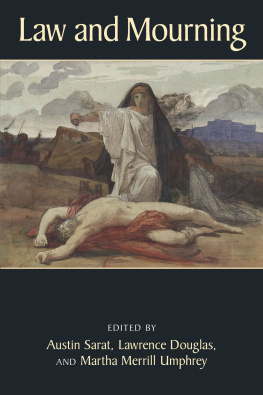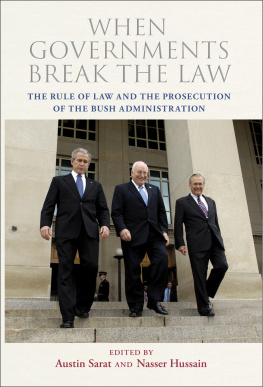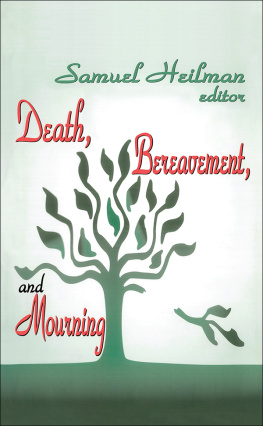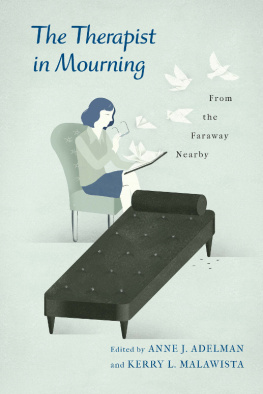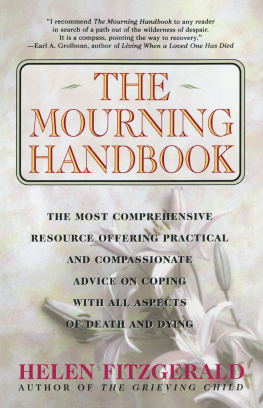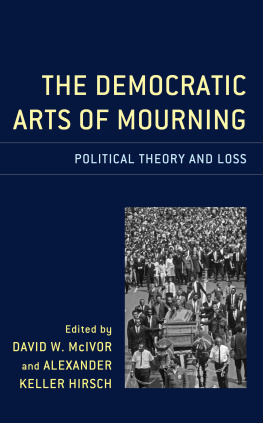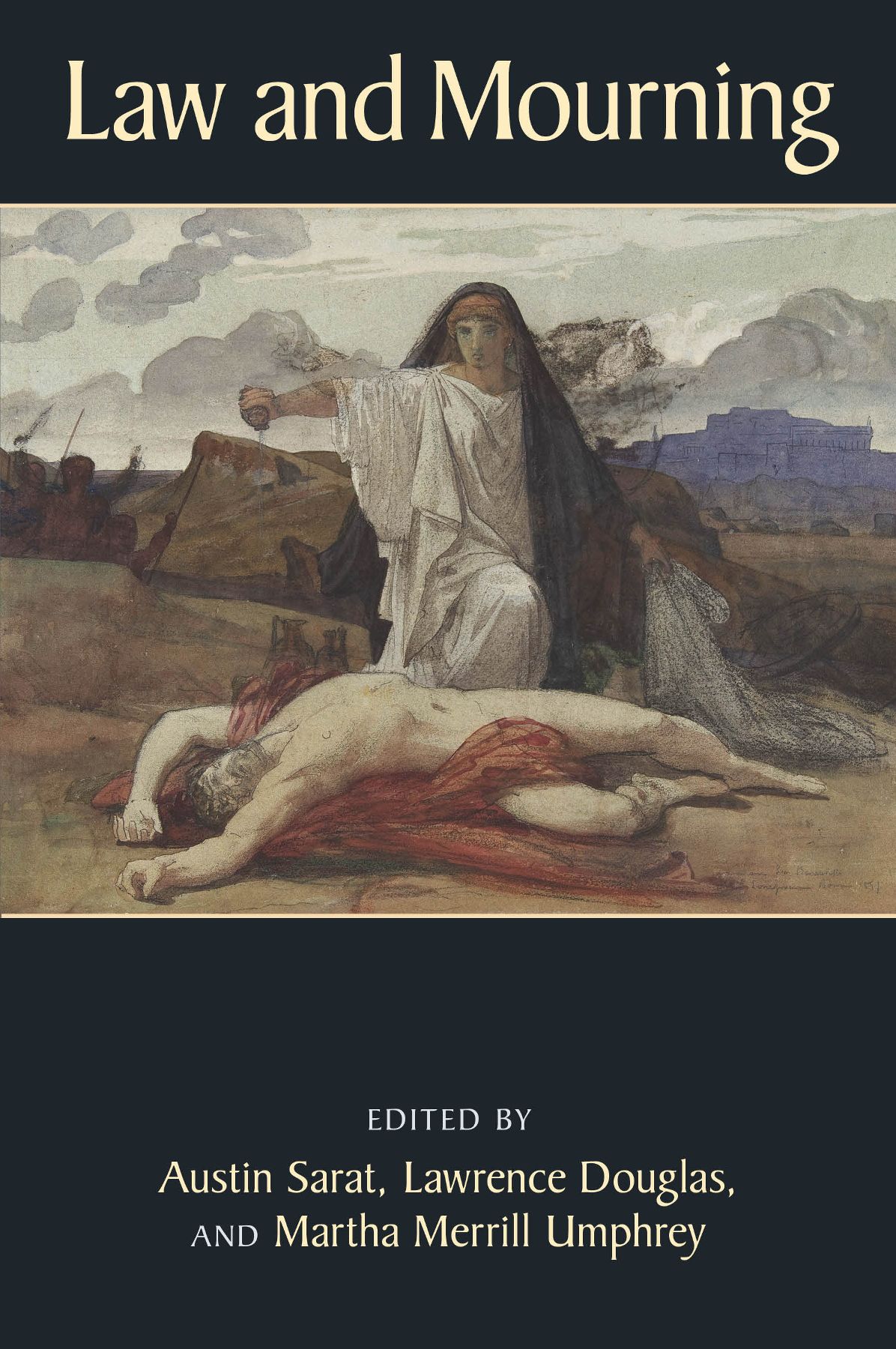
Law and Mourning
A volume in
The Amherst Series in Law, Jurisprudence, and Social Thought
Edited by
Austin Sarat
Martha Merrill Umphrey
Lawrence Douglas
Law and Mourning
Edited by
Austin Sarat
Lawrence Douglas
Martha Merrill Umphrey
University of Massachusetts Press
Amherst & Boston
Copyright 2017 by University of Massachusetts Press
All rights reserved
Printed in the United States of America
ISBN 978-1-61376-531-9
Cover design by Jack Harrison
Cover art: Jules-Eugne Lenepveu (French, Angers 18191898 Paris), Antigone Gives Token to the Body of Her Brother Polynices, 183598. Ian Woodner Family Collection Fund, 1991, the Metropolitan Museum of Art, New York.
Library of Congress Cataloging-in-Publication Data
Names: Sarat, Austin, editor. | Douglas, Lawrence, editor. | Umphrey, Martha Merrill, editor. Title: Law and mourning / edited by Austin Sarat, Lawrence Douglas, Martha Merrill Umphrey. Description: Amherst : University of Massachusetts Press, 2017. | Series: Amherst series in law, jurisprudence, and social thought | Includes bibliographical references and index. Identifiers: LCCN 2017012817| ISBN 9781625342836 (pbk. : alk. paper) | ISBN 9781625342829 (hardcover : alk. paper) Subjects: LCSH: Mourning customsUnited States. | LawSocial aspectsUnited States. Classification: LCC GT3390 .L38 2017 | DDC 393/.9dc23
LC record available at https://lccn.loc.gov/2017012817
British Library Cataloguing-in-Publication Data
A catalog record for this book is available from the British Library.
For our friend and colleague Nasser Hussain
Contents
Martha Merrill Umphrey, Austin Sarat, Lawrence Douglas
Ray D. Madoff
Shai J. Lavi
Andrea Brady
Ann Pellegrini
Mark Sanders
Catherine Kellogg
We are grateful to our Amherst College colleagues David Delaney and Adam Sitze for their intellectual companionship and our students in Amherst Colleges Department of Law, Jurisprudence, and Social Thought for their interest in the issues addressed in this book. We would like to express our appreciation for generous financial support provided by Amherst Colleges Corliss Lamont Fund. We dedicate this book to Nasser Hussain, whose untimely death deprived us, our students, and the world of a brilliant mind and a beautiful soul.
Law and Mourning
An Introduction
Martha Merrill Umphrey, Austin Sarat, and Lawrence Douglas
Yoking law and mourning together may seem counterintuitive. Mourn-ing, Freud observes, involves grave departures from the normal attitude toward life. The painful experience of loss causes a mourner to lose interest in the outside world, temporarily pulling him or her into an altered temporality saturated by the past and devoid of an imaginable future. Death, it turns out, is no real end; rather, it is remarkably generative for those who live on, in ways both predictable and sometimes destabilizing. Those who mourn a loss seem immersed in another realm, detached from reality, indifferent or unresponsive to rule and reason, exempt from the usual rules and timetables of everyday life.
What does law have to do with such a deeply human, otherworldly state? As the chapters in this volume suggest, law is bound up with and responsive to mourning in many ways. Mourning is constituted in relation to social norms and institutions that, through rule and ritual, absorb, regulate, and contend with loss and its reverberations.
Law helps to give meaning to death and mourning, establishing rules that require a clear demarcation of the boundary between life and death, tell us what we can and cannot do with the remains of the dead, and create privileges and disabilities for survivors. These rules are found in criminal law, health law, and laws governing inheritance. Law seeks to channel the powerful emotions associated with it, and protect those vulnerable to them, in order to limit social confusion and conflict. Yet mourning can also generate critiques of existing legal and political orders that seem compelled by calls from the dead, unleashing an indifference to legal consequences in mourners that can undermine or destroy law.
To be both in mourning and in laws world, one is subject to different sovereigns, sometimes aligned but sometimes at odds. The chapters that follow trace the borders arising from this state of mourning in law itself, between law and politics, and ultimately in acts of judgment and justice.
Governing the State of Mourning
We might characterize mourning as a psychic relation between the living and the lost, shaped in part by the surrounding social world. Mourning involves an internal process of detaching from someone or something that has passed away. In his classic essay Mourning and Melancholia (1917), Freud suggests that in mourning, the existence of the lost object is psychically prolonged internally, in opposition to the evident reality of loss. Mourners lack interest in the outside world, cannot adopt a new love object, and turn away from any activity not connected with thoughts of the lost object. Delineations of self and other collapse spatially as the image of the lost object emerges inside the subjectivity of mourners. Moreover, this incorporation of the lost object carries it forward temporally as memory, as part of the living, in ways that can generate action on behalf of the dead.
Those attachments play out in the social world as well. Anthro-pologists and sociologists identify the state of mourning in culturally defined actsrites, rituals, and customsthat take place after a death and offer a means of transition for both the deceased and the bereaved. They are the social expression of, or perhaps protective shell for, the painful psychic detachment mourning involves. While mourning may feel singular, individualized, and profoundly subjective, defined by an aloneness and apartness from the world, it simultaneously produces a powerful and continuing set of attachments among the living and with the dead.
Law plays an important role in organizing death and its reverberations. As Ray Madoff argues below, the law of the dead is everywhere, affecting not only what follows from an individuals death (e.g., the disposition of bodies and property) but the very definition of death itself. We call on law first to define criteria for death, to name it performatively so as to transform a person into remains. These criteria can vary. Is death defined by the cessation of breath? Of brain activity or cellular deterioration? What can death mean when transplanted organs continue to support someone elses life? Law negotiates and fixes the otherwise confusing boundary between life and death.
Perhaps more familiarly, law regulates the material remainders of those who have died: their bodies, their money and property, their reputations. With the proliferation of new technologies (e.g., cryogenics) and legal instruments (in the form of, e.g., trust arrangements that constrain heirs in unusual or even unjust ways), this task has grown more and more complex. As Shai Lavi suggests below, perplexing questions arise with, the possibility of something like posthumous sperm retrieval. When is it ethical? Only under conditions in which it had prior authorization by the deceased, or when family or prospective family desires it? Addressing such questions, law mediates continuing relations between the living and the dead.
Law also recognizes and contains intense emotional responses to death. Most fundamentally, states impose laws, processes, and sanctions on wrongdoers as a means of quashing and delegitimizing acts of private vengeance. can nevertheless threaten laws efforts to maintain itself as a site of reason and restraint as survivors themselves become victims, damaged beyond recognition by loss.
Next page
